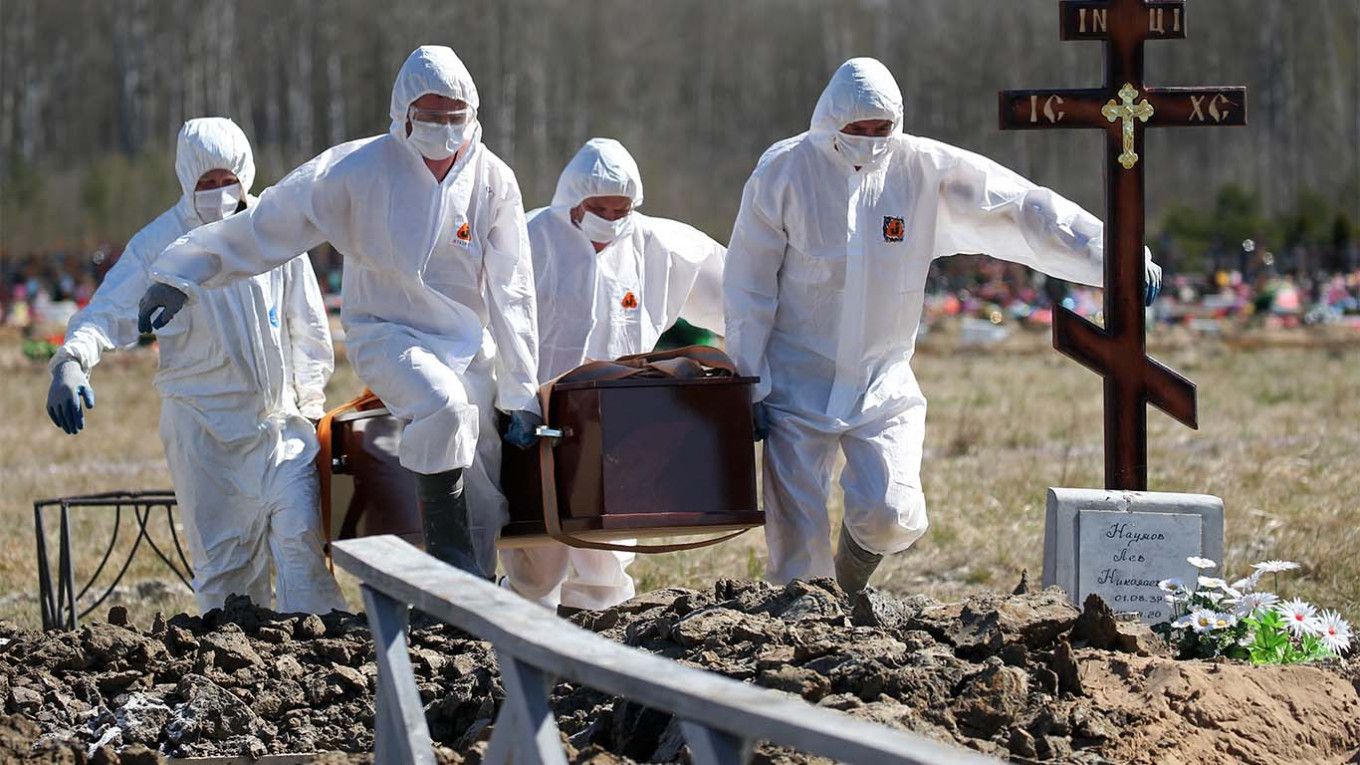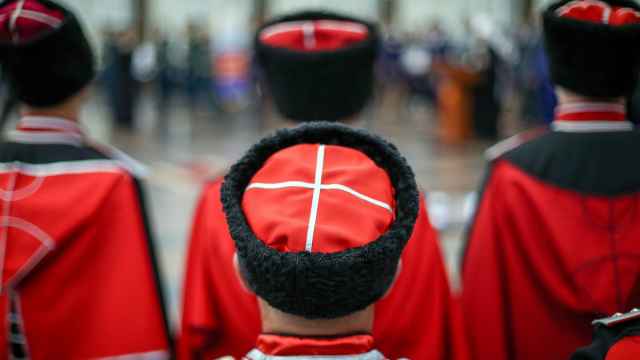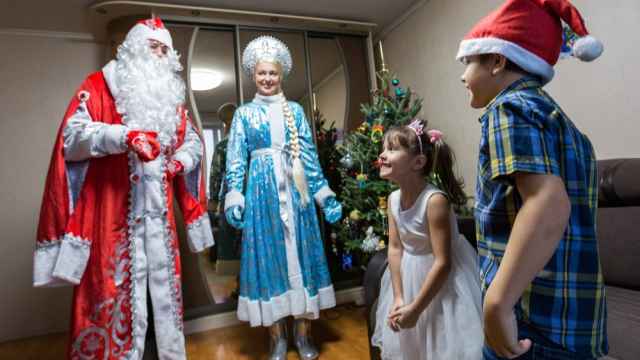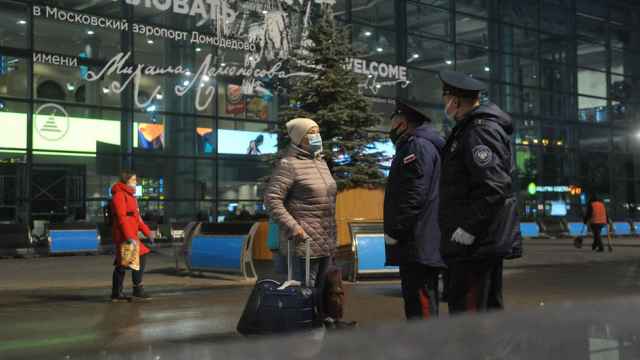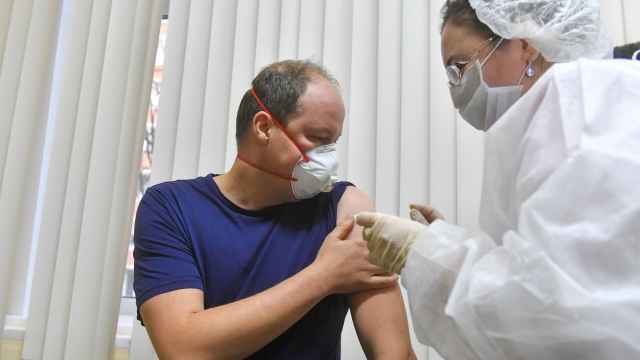Suspicions are growing that Russia is undercounting its coronavirus death toll. Although the country has the second fastest growing outbreak in the world after the United States, its mortality rate falls far below other countries.
On Friday, Russia reported 187,859 coronavirus cases to only 1,723 deaths, putting it in fifth place globally for case numbers with a mortality rate of only 0.9%.
But the official coronavirus information page for the Urals region of Chelyabinsk presents two statistics — the only Russian region to do so — that help address the disparity. Taken together, they get to the heart of a debate beginning to rage over which country has handled the contagion best.
Covid-19, the page reports, has so far killed three people in the region, while another seven tested positive but died from another cause.
The second figure would have boosted Chelyabinsk’s coronavirus death toll by 233% but was not included in the state toll because Russia does not automatically list Covid-19 as the cause of death if the deceased tested positive for the coronavirus.
According to one expert with knowledge of the Health Ministry’s plans, the practice of publishing both sets of figures looks set to become the norm within weeks, indicating that Russia is becoming increasingly transparent about its classification process.
“When this all blows over, I believe mortality figures will be in two camps: deaths specifically from Covid-19 and deaths of people who had the virus but weren’t killed by it,” said Andrei Chernyayev, a pulmonologist who helped write the Moscow Health Department’s rules for classifying coronavirus deaths.
“I believe Russia is counting accurately while others like Italy, Belgium and the United States are over counting,” he added.
Varying methods
While the World Health Organization has published complicated guidelines for classifying coronavirus deaths, experts complained that they arrived late in the pandemic — on April 16 — when many countries had already made their own decisions on categorization. Plus, experts said, some countries had by then already counted the bulk of their deaths.
Belgium adopted the most liberal method for classifying coronavirus deaths. To take one example, the country records coronavirus deaths in nursing homes even if the virus was only suspected in the deceased, not confirmed. Unsurprisingly, its coronavirus mortality rate is the highest in the world.
Meanwhile, Italy and the United States — as well as many European countries — automatically classify deaths as caused by the coronavirus if the deceased tested positive.
Russia falls on the more conservative end of the spectrum. The country has continued relying on its traditional method of determining the underlying cause of death that sees it carry out autopsies in up to 70% of deaths compared with about 10% in many European countries, said Sergei Timonin, a demographer with the Higher School of Economics.
According to Health Ministry guidelines, “in the absence of clinical manifestations and pathological changes, especially in the lungs” as a result of the virus, Covid-19 is not listed as the cause of death.
Put another way, if a person has a brain hemorrhage after earlier testing positive for the coronavirus, the cause of death will be classified as the hemorrhage, not Covid-19, Chernyayev explained.
Increased transparency
In recent days, Russia has become increasingly transparent about this practice.
“We can’t put everything down to the coronavirus otherwise we won’t act correctly,” the Health Ministry’s head pathologist Georgiy Frank told the Ekho Moskvy radio station Monday. “The numbers have to be objective. Covid is often the cause, but not always.”
In addition to Chelyabinsk, The Moscow Times found three other regions that have announced statistics for deaths from coronavirus and deaths of patients who were coronavirus-positive. Using the more liberal classification method in Sverdlovsk would have increased deaths by 233%, while numbers in Saratov would have risen by 200% and in Ryazan by 60%.
Russia is planning to make these figures available nationwide by publishing a database that will contain both sets of statistics for all regions “within several weeks,” according to a source, who has seen the Health Ministry’s preliminary dataset. The Health Ministry did not immediately respond to a request for comment.
Based on official data, Timonin said that for Moscow, the epicenter of Russia’s coronavirus outbreak, the 956 coronavirus deaths that have been recorded account for only about 35% of all coronavirus-positive patient deaths in the Russian capital.
“More than 1,500 additional patients who tested positive for the coronavirus have died, but in those cases pathologists decided the virus did not play a decisive role,” Timonin said.
Room for interpretation
Some critics, however, worry that Russia’s classification methodology gives officials the ability to pressure pathologists into undercounting coronavirus death totals or massage figures themselves.
“I myself see that I have diagnosed more patients who died from the coronavirus in these past two weeks than I saw in official statistics,” said a pathologist in St. Petersburg who asked to remain anonymous.
The pathologist, however, also noted that because of Russia’s intensive classification process there can be a lag of about two to three weeks before coronavirus deaths make it into the official data.
Still, a statistician who works with the Russian government but asked to remain anonymous because they weren’t authorized to speak on the subject said that they had already seen evidence that some regions were manipulating data.
Others have pointed to an unofficial tally by Russian doctors that lists over 100 medical workers who have died from the coronavirus and rivals Italy’s count — although the countries’ death totals differ drastically — as evidence of foul play. Spikes in cases of pneumonia in certain regions have also sparked suspicion.
And, despite Russia having reportedly carried out over 4 million coronavirus tests, officials themselves have said that the tests often give the wrong result. Without a positive test result, a pathologist will not register a death having been due to Covid-19.
Alexander Vanyukov, a surgeon at Moscow’s Clinical Hospital No. 52, told the investigative Proekt outlet last week that he has his doubts over Russia’s official statistics. He explained that, at his hospital, which is one of 20-plus in Moscow and was one of the best prepared for the pandemic, about 10-20 coronavirus patients are dying each day.
“We will probably never know the real figures. Or, as one of our colleagues joked, we’ll find out only in about 30 years on HBO,” he said, in reference to the channel’s popular ‘Chernobyl’ series.
Measuring the true toll
Experts who spoke with The Moscow Times said that Russia’s method for counting deaths allows for some leeway in interpretation. But they added that, even if the country is undercounting, they haven’t seen any signs that it is doing so on such a massive scale that would suggest its toll is anywhere close to some of the harder hit countries in the world.
They also stressed that, at this point, there is no use in comparing mortality rates in various countries.
Instead, Vladimir Shkolnikov, a demographer at the Max Planck Institute for Demographic Research and director of the Higher School of Economics’ International Laboratory for Population and Health Research, believes, like many other experts around the world, that the most effective method for understanding the true toll of the coronavirus pandemic is counting excess mortality — or all-cause mortality — deaths during the period.
“A death is a well registered event,” he said. “If we see that in a given week there were suddenly a lot more deaths than the same period in previous years, then we can say that there was some short-term factor. This is what we do for heat waves or flu epidemics.”
Shkolnikov pointed to counts from the EuroMOMO European mortality monitoring project and newspapers like the Financial Times and the New York Times for countries where data is readily available. In all cases, even in countries counting coronavirus deaths liberally, excess deaths came in higher.
At the moment, however, compiling an excess deaths count for Russia is much trickier. For one, the federal statistics agency Rosstat will only release figures for April at the end of May or in early June. But even that is not enough for an accurate count, said Shkolnikov.
“If the curve in coronavirus cases began growing in the middle of April, the data for the first two weeks will skew our count,” he explained. “We need to look week by week.”
Those numbers, however, usually come out by the fall of the following year — or around September 2021 for the current period.
Political points
By then, though, political points will already have been scored.
At the end of April, the head of Russia’s health watchdog Rospotrebnadzor Anna Popova boasted on national television to President Vladimir Putin that the country’s low mortality rate is a sign it is handling the contagion well.
And in response to an article in the U.K.’s Financial Times on the crisis facing Putin due to the pandemic, Russia’s First Deputy Permanent Representative to the United Nations Dmitry Polyanskiy likewise pointed to the mortality rate.
“A very biased and shallow analysis,” he tweeted. “Not even mentioned that #Russia has one of the lowest #COVID-related mortality rate in the world (UK-the highest in Europe).”
A Message from The Moscow Times:
Dear readers,
We are facing unprecedented challenges. Russia's Prosecutor General's Office has designated The Moscow Times as an "undesirable" organization, criminalizing our work and putting our staff at risk of prosecution. This follows our earlier unjust labeling as a "foreign agent."
These actions are direct attempts to silence independent journalism in Russia. The authorities claim our work "discredits the decisions of the Russian leadership." We see things differently: we strive to provide accurate, unbiased reporting on Russia.
We, the journalists of The Moscow Times, refuse to be silenced. But to continue our work, we need your help.
Your support, no matter how small, makes a world of difference. If you can, please support us monthly starting from just $2. It's quick to set up, and every contribution makes a significant impact.
By supporting The Moscow Times, you're defending open, independent journalism in the face of repression. Thank you for standing with us.
Remind me later.




